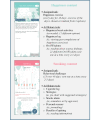Smoking Cessation Smartphone App for Nondaily Smoking With Telephone Onboarding: Proof-of-Concept Randomized Controlled Trial
- PMID: 39814363
- PMCID: PMC11780296
- DOI: 10.2196/53971
Smoking Cessation Smartphone App for Nondaily Smoking With Telephone Onboarding: Proof-of-Concept Randomized Controlled Trial
Abstract
Background: Nondaily smoking is a widespread and increasingly prevalent pattern of use. To date, no effective treatment approach for nondaily smoking has been identified.
Objective: This study aimed to conduct an unblinded randomized controlled trial to evaluate proof-of-concept markers of the Smiling instead of Smoking (SiS) app, a smartphone app for smoking cessation, designed specifically for people who smoke less than daily, within the framework of positive psychology.
Methods: Overall, 226 adults who smoke less than daily were recruited on the web and asked to undertake a quit attempt while using assigned smoking cessation support materials. Participants were randomly assigned to 1 of 3 materials: the SiS smartphone app, the National Cancer Institute's smartphone app QuitGuide (QG), or the National Cancer Institute's smoking cessation brochure, "Clearing the Air" (CtA). All participants engaged in a 15-minute scripted onboarding phone call and were introduced to their support materials to use for the next 7 weeks. Follow-up self-assessment web surveys were sent 2, 6, 12, and 24 weeks after participants' initially chosen quit date (ie, 1 week after onboarding). The primary outcome for this study was self-efficacy to remain abstinent from smoking at treatment end. Secondary outcomes assessed treatment acceptability, treatment feasibility (eg, number of days of app use, time spent using app, and use of smoking cessation strategies), and secondary proof-of-concept efficacy outcomes (eg, positive affect, craving, and attitudes toward smoking). Smoking outcomes (ie, 30-day point prevalence abstinence and smoking reduction) were also assessed.
Results: Results indicated a significant effect of treatment on the primary outcome, where SiS participants (n=80) reported higher self-efficacy to abstain from smoking at the end of treatment than the 2 control groups (QG: n=75; P=.02; Cohen d=0.40 and CtA: n=71; P=.007; Cohen d=0.50). This effect was also significant on both self-efficacy subscales (ie, internal cues and external cues) with effect sizes ranging from Cohen d=0.34 to 0.50 across the pairwise comparisons. The SiS app group also reported lower craving (QG: P=.005; Cohen d=-0.57 and CtA: P=.005; Cohen d=-0.57) and higher positive affect than QG (QG: P=.01; Cohen d=0.44 and CtA: P=.05; Cohen d=0.38); attitudes toward smoking were largely similar across groups. Treatment acceptability was comparable across groups (P values for all groups >.05; Cohen d range 0.06-0.23). Treatment feasibility measures indicated that participants used the SiS app on 33 out of 49 days, for 35 to 40 minutes per week, resulting in greater use of smoking cessation strategies than QG (QG: P=.04; Cohen d=0.38 and CtA: P=.16; Cohen d=0.24).
Conclusions: These findings provide strong evidence for the conceptual underpinnings of the SiS app, and thereby provide compelling justification for conducting a large-scale randomized controlled trial that can test the effectiveness of the SiS app on smoking cessation.
Trial registration: ClinicalTrials.gov NCT04672239; https://clinicaltrials.gov/study/NCT04672239.
International registered report identifier (irrid): RR2-10.2196/40867.
Keywords: mHealth; mobile health; mobile phone; nondaily smoking; positive psychology; smartphone; smoking; smoking cessation.
©Bettina B Hoeppner, Kaitlyn R Siegel, Allison E Futter, Diadora Finley-Abboud, Alivia C Williamson, Christopher W Kahler, Elyse R Park, Susanne S Hoeppner. Originally published in JMIR mHealth and uHealth (https://mhealth.jmir.org), 15.01.2025.
Conflict of interest statement
Conflicts of Interest: None declared.
Figures
References
-
- Creamer MR, Wang TW, Babb S, Cullen KA, Day H, Willis G, Jamal A, Neff L. Tobacco product use and cessation indicators among adults - United States, 2018. MMWR Morb Mortal Wkly Rep. 2019 Nov 15;68(45):1013–9. doi: 10.15585/mmwr.mm6845a2. https://doi.org/10.15585/mmwr.mm6845a2 - DOI - DOI - PMC - PubMed
-
- Hoeppner BB, Bidwell LC, Colby SM, Barnett NP. Smoking patterns and their relationship to drinking among first-year college students. Nicotine Tob Res. 2014 Jun 10;16(6):743–52. doi: 10.1093/ntr/ntt205. https://europepmc.org/abstract/MED/24415586 ntt205 - DOI - PMC - PubMed
Publication types
MeSH terms
Associated data
LinkOut - more resources
Full Text Sources
Medical
Miscellaneous



